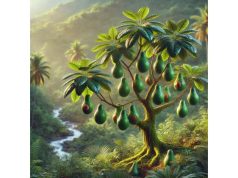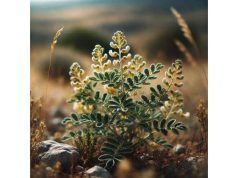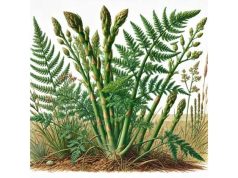
Allspice—scientifically identified as Pimenta dioica—is an aromatic spice derived from the dried unripe berries of a tropical evergreen tree in the myrtle family (Myrtaceae). Native to the lush tropical climates of the Caribbean, particularly Jamaica, allspice earned its name from early European explorers who likened its flavor to a unique blend of cinnamon, nutmeg, and clove. The small, dark brown berries exude a warm, sweet, and slightly peppery aroma, making them a prized addition to global cuisines—from jerk seasonings and baked goods to spiced beverages and pickling. Beyond the kitchen, allspice’s essential oil holds a cherished place in traditional remedies, focusing on digestion, joint comfort, and minor respiratory support.
Rooted in the Taino culture before Columbus, allspice quickly gained renown among explorers, merchants, and European monarchies vying for control of the “New World” spice trade. Over centuries, it has influenced not just culinary artistry but folk medicine practices. Modern research highlights the spice’s eugenol-rich volatile oils, potentially conferring anti-inflammatory, analgesic, and antimicrobial properties. However, as with many potent herbs, prudent use is essential. This comprehensive guide delves into allspice’s botanical characteristics, storied journey through history, chemical composition, therapeutic benefits, usage guidelines, and current scientific insights. Whether you’re a food aficionado, herbal enthusiast, or simply intrigued by the synergy of spices, allspice offers an aromatic gateway to holistic wellness and captivating culinary experiences.
- Distinctive flavor melding elements of clove, nutmeg, cinnamon, and pepper
- Traditional digestive support and mild analgesic properties
- Historic significance in Caribbean, Latin American, and global spice trade
- Rich supply of eugenol, an essential oil with documented antibacterial effects
- Culinary versatility spanning sweet, savory, and pickling recipes
Table of Contents
- Allspice: Notable Plant Traits and Botanical Overview
- Allspice: Cultural Legacy and Historical Importance
- Allspice: Key Chemical Components and Phytochemicals
- Allspice: Core Benefits and Essential Properties
- Allspice: Applications, Preparations, and Safety Considerations
- Allspice: Significant Studies and Emerging Research
- Allspice: Frequently Asked Questions
Allspice: Notable Plant Traits and Botanical Overview
Taxonomy and Classification
Allspice, or Pimenta dioica, is a tropical evergreen tree within the Myrtaceae family, which also includes guava, clove (Syzygium aromaticum), and eucalyptus. The genus Pimenta is closely related to Syzygium, though morphological distinctions (leaf shape, fruit structure, flower arrangement) led taxonomists to keep them separate.
Geographic Distribution and Habitat
- Native Range:
- Primarily found in the Greater Antilles (especially Jamaica), parts of Central America, and some northern South American locales.
- Jamaica remains the largest commercial producer, with “Jamaican allspice” recognized for its superior pungency and complex flavor notes.
- Global Spread:
- Colonial-era spice routes introduced allspice to Asia and Africa, though it never rivaled local spices like cloves or pepper in those regions.
- Modern horticultural attempts have transplanted it to tropical greenhouse settings or suitable climates worldwide, albeit at smaller scales.
Physical Description
- Tree and Foliage:
- Allspice can grow up to 10–18 meters in its native environment. The trunk is typically slender and smooth-barked.
- Leaves are elliptical, glossy, and leathery, around 6–15 cm long. Crushed leaves exude a clove-like aroma, reflecting eugenol content.
- Flowers:
- Small, white, star-shaped blossoms appear in clusters. Pollination fosters berry development. Bees and other insects frequent these fragrant blooms.
- Berries (Drupes):
- Round, ~4–7 mm in diameter, turning from green to purple-brown upon maturation.
- Commercially harvested when green (unripe) for peak essential oil content and dried until they adopt a dark brown hue.
Cultivation and Harvest
- Soil and Climate Needs:
- Thrives in warm, humid conditions with moderate rainfall. Prefers well-drained loamy soils.
- Susceptible to frost or severe cold, limiting large-scale production to tropical or subtropical zones.
- Propagation:
- Often grown from seeds or young nursery plants. Germination can be slow, requiring consistent moisture and warmth.
- Grafted trees may help ensure consistent fruit quality and earlier bearing.
- Harvest Process:
- Berries are handpicked when just turning from green to a tinge of purple—optimal for preserving aroma.
- Dried under the sun or in dehydrators, resulting in pea-like pods with a wrinkled surface.
Economic and Culinary Significance
- Spice Industry:
- Allspice stands among the major tropical spices, though overshadowed by black pepper or clove in total volume.
- Jamaican allspice commands premium prices, reflecting superior oil concentration and hallmark warmth.
- Distinct Flavor Profile:
- The name “allspice” originated from its taste reminiscent of combined clove, cinnamon, nutmeg, and pepper.
- In cooking, it provides a warming, slightly sweet depth to both sweet and savory dishes.
Whether serving as a bold fragrance in jerk seasoning or an aromatic highlight in mulled wine, allspice’s robust presence underscores its valued place in tropical horticulture and global culinary tradition. Its morphological traits, from glossy leaves to richly scented berries, confirm its distinctive identity in the spice pantheon.
Allspice: Cultural Legacy and Historical Importance
Pre-Columbian and Indigenous Use
- Taino and Arawak Traditions:
Native peoples of the Caribbean, especially the Taino, recognized the pungent berries’ flavor and preservative qualities long before European arrival. They combined it with meat or fish to enhance preservation and impart a spicy edge, an early precursor to jerk-style cooking.
European Discovery and Colonial Era
- Christopher Columbus and Spanish Explorers:
- Columbus encountered allspice during his voyages, mistaking it for pepper (leading to the misnomer “pimiento”). This confusion contributed to early trades labeling it as Jamaican pepper or pimento.
- Spanish colonists swiftly recognized its commercial value, sending shipments back to Europe.
- Wider European Adoption:
- By the 17th and 18th centuries, allspice entered the spice mix of English, Dutch, and French trading companies. Bakers and picklers throughout Europe found it indispensable for sweet pastries, pickles, and spiced meats.
- In British cuisine, allspice overshadowed black pepper in certain sausage recipes, while in Germany, it found a niche in sweet baked goods.
Role in American Settler Culture
- Colonial and Pioneer Cuisines:
- In early North America, allspice was integrated into fruitcakes, pies, and preserved foods. Dutch settlers famously used it in spiced cookies.
- New Orleans and Creole:
- The city’s fusion cooking adopted Jamaican influences, featuring allspice in gumbo and marinade rubs.
Middle Eastern and Mediterranean Ties
- Turkish and Levantine Cooking:
- Some Middle Eastern or Turkish recipes incorporate “English spice” (another name for allspice) in lamb dishes or kibbeh spice mixes.
- Greek and Balkan Spices:
- Allspice occasionally appears in stews, sauces, and pickling brines, giving a subtle sweet warmth distinct from cinnamon or clove alone.
Modern Evolution and Global Recognition
- Caribbean Identity:
- Jamaican jerk marinade stands as allspice’s global ambassador, combining it with scotch bonnet peppers, thyme, and onion for a signature fiery-sweet taste.
- Also used in Jamaican rum-based cocktails or bitters, bridging gastronomic tradition with beverage artistry.
- Commercial Spice Blends:
- Found in commercial pumpkin spice mixes, barbecue rubs, and holiday blends. The spice’s universal charm cements its presence in packaged seasoning lines.
- Contemporary Culinary Trends:
- Chefs integrate allspice in fusion cuisines, pairing it with unexpected global flavors (like coconut curry or mole sauce) to craft depth.
From indigenous Caribbean diets to European holiday baking, allspice’s centuries-long journey highlights a bridging of cultural boundaries. Its footprints in colonial trade, gastronomic evolution, and modern artisanal recipes affirm a timeless flavor synergy—one that transcends continents and culinary eras.
Allspice: Key Chemical Components and Phytochemicals
Allspice’s alluring aroma and gentle heat stem from an interplay of volatile and non-volatile compounds contained within its dried berries. Understanding these constituents illuminates both its flavor complexity and possible health effects.
Essential Oils and Aromatic Molecules
- Eugenol:
- The primary active constituent, eugenol lends allspice much of its clove-like fragrance.
- Exhibits notable antibacterial, antifungal, and anti-inflammatory properties, fueling potential therapeutic and preservative applications.
- Caryophyllene:
- A sesquiterpene also found in black pepper and clove; contributes subtle spiciness and additional anti-inflammatory synergy.
- Cin eol, Limonene, and Additional Terpenes:
- Found in smaller amounts, refining the overall aroma with delicate fruity or citrus undertones.
Tannins and Polyphenols
- Tannic Acid and Related Polyphenols:
- Impart mild astringent action, potentially aiding digestive toning or mild anti-inflammatory support.
- Contribute to allspice’s antioxidant profile, though less studied compared to eugenol’s direct effects.
Vitamins and Minerals
- Trace Nutrients:
- Ground allspice may contain modest amounts of vitamin C, vitamin A, and B vitamins.
- Contains essential minerals like iron, copper, manganese, though typically in small concentrations that form only a minor dietary supplement.
Flavonoids
- Quercetin and Kaempferol Glycosides:
- These common flavonoids might enhance the spice’s protective and anti-inflammatory potential.
- Present in trace amounts, overshadowed by eugenol’s aromatic impact.
Others: Fiber and Carbohydrates
- Dietary Fiber:
- Minimal in typical usage amounts, though a small portion of carbs and fiber does exist in the ground spice.
- Plant Waxes, Resins:
- Contribute to the spice’s structure, not significantly used or studied from a nutritional angle.
Distillation and Extracts
- Oil Extraction:
- Steam distillation of allspice yields a pale yellow to brownish essential oil with high eugenol content (up to 65-80%).
- Tinctures or extracts often harness these same volatile oils, used in flavoring or mild herbal applications.
Potential for Toxicity or Irritation
- Eugenol’s Double-Edged Sword:
- Though beneficial in controlled amounts, eugenol can irritate skin or mucous membranes if heavily concentrated.
- Excess ingestion might cause GI upset or liver stress, though typical culinary doses pose minimal risk.
- Safe Culinary Levels:
- The modest usage in cooking (1–2 teaspoons or less per dish) remains generally safe for healthy adults.
- Concentrated essential oil requires appropriate dilution.
Hence, allspice’s distinctive “all-in-one” flavor arises chiefly from eugenol blended with a supporting cast of caryophyllene, polyphenols, and subtle terpenes. This synergy underpins both its culinary enchantment and mild potential for health support, albeit best utilized in moderation.
Allspice: Core Benefits and Essential Properties
Allspice, beyond its culinary allure, offers a variety of gentle, supportive health benefits. These primarily derive from the synergy of eugenol’s anti-inflammatory capacity, the spice’s mild antimicrobial action, and its comforting warmth for digestion.
1. Digestive Comfort and Carminative Action
- Reducing Gas and Bloating:
- Eugenol’s spasmolytic effects can soothe stomach cramps or bloating.
- In certain folk practices, lightly brewed allspice tea or ingestion of warm spiced beverages helps ease indigestion.
- Stimulating Appetite:
- Like many aromatic spices, allspice can gently stimulate saliva and digestive enzyme secretion, potentially assisting mild appetite enhancement or sluggish digestion.
2. Anti-Inflammatory and Mild Analgesic Effects
- Eugenol’s Impact:
- Similar to clove oil, eugenol in allspice may moderate inflammation, reducing minor joint or muscle aches.
- Some references mention applying allspice compresses or diluted essential oil topically for mild arthritic pains or sore muscles.
- Possible Headache Relief:
- Historically, spiced teas or inhaling the fragrant steam might help lighten tension headaches, though this is largely anecdotal.
3. Antimicrobial and Antifungal Potential
- Food Preservation and Microbial Inhibition:
- Eugenol can combat bacteria, helping preserve pickles or relishes. Caribbean jerk seasoning partly owes its shelf-stable nature to allspice’s antibacterial properties.
- Oral Health Tidbits:
- Gargling with a mild infusion or using essential oil in mouthwashes may discourage bad breath-causing bacteria, paralleling clove’s dental usage.
4. Respiratory and Cold Support
- Warming Expectorant Quality:
- In older folk medicine, spiced drinks containing allspice might help shift mild chest congestion or encourage mucus clearance, akin to how chili or ginger might function.
- Eugenol’s warming trait can bring comforting relief to the sinuses or throat.
5. Rich Antioxidant Profile
- Oxidative Stress Reduction:
- Tannins, eugenol, and flavonoids collectively lend free radical scavenging activity.
- Supports general cellular protection but not a cure-all, best integrated into a broad healthy diet.
6. Emotional and Soothing Aspects
- Aromatherapeutic Calm:
- The comforting, spicy scent in mulled drinks or essential oil diffusions can help create a cozy environment.
- Minimal sedative effect compared to lavender or chamomile, but can be psychologically uplifting in aromatic blends.
Balancing Perspective
- Mild vs. Strong Effects:
- Allspice exerts gentler influences than high-dose clove or cinnamon. Its broad benefits are subtle yet valuable in consistent, moderate usage.
- Complementary Role:
- Combine with warming spices like cinnamon, ginger, or cardamom for synergy in digestive or respiratory blends.
- Individual Variability:
- Some individuals are more sensitive to eugenol’s warming effect. Monitor personal tolerance when sampling new herbal combinations.
Consequently, allspice’s health-related uses pivot around warming digestion, mild analgesia, and antibacterial hints. These supportive properties reinforce the spice’s traditional “winter comfort” role in stews, pastries, and soothing beverages. While not a medical powerhouse, it stands as a faithful culinary ally with beneficial side perks.
Allspice: Applications, Preparations, and Safety Considerations
From holiday baking to spice-infused self-care, allspice shines across the culinary, cosmetic, and herbal realms. Yet mindful handling ensures its distinctive pungency does not overwhelm or irritate.
Culinary Uses
- Baking and Desserts:
- A staple in pumpkin pie spice, gingerbread, fruit cakes, or cookie recipes.
- Often complements apples, pears, or other fruits in pies, delivering warm complexity reminiscent of cinnamon-clove synergy.
- Savory Dishes:
- Integral to Caribbean jerk rubs or marinade for chicken, pork, or fish.
- Middle Eastern and Eastern European recipes occasionally incorporate ground allspice in stews, sauces, or meatloaf.
- Pairs seamlessly with onion, garlic, thyme, and scotch bonnet peppers in Jamaican cuisine.
- Pickling and Preserving:
- Whole allspice berries bring a subtle bite to pickles, relishes, or brine solutions for corned beef.
- Adding 4–5 berries in a quart of pickling solution is typical for tangy accent.
- Beverages:
- Mulled wine or cider typically includes a pinch of allspice along with cinnamon and clove.
- Coffee or hot chocolate might adopt a dash for a cozy twist.
Herbal Infusions and Teas
- Digestive Brew:
- A mild infusion uses 1/2 to 1 teaspoon of freshly ground allspice per cup of hot water, steeped 5–10 minutes.
- Helps with mild indigestion or creates a warming beverage on cold days.
- Combined Spice Teas:
- Blending with cinnamon, ginger, or cardamom intensifies warming effects. Honey or maple syrup sweetens the robust flavor.
Essential Oil and Aromatherapy
- Allspice Essential Oil:
- Often called pimento leaf or pimento berry oil. Rich in eugenol, carrying a distinct spicy aroma reminiscent of clove.
- Must be used with caution in aromatherapy; can irritate skin if undiluted. A patch test is recommended.
- Topical Rubs or Balms:
- A few drops of diluted allspice oil in a carrier can produce a warming rub for sore muscles or stiff joints.
- Overuse or excessive concentration may cause redness or irritation.
Safety, Dosage, and Precautions
- Moderation in Culinary Settings:
- 1–2 teaspoons of ground allspice in a family-sized dish is typical. Over-seasoning can turn flavor acrid or cause GI upset.
- Pregnant individuals can consume it in normal culinary amounts, though caution with large doses or concentrated forms is prudent.
- Potential Sensitivities:
- Eugenol might irritate certain individuals’ gut or skin. Start small or test topically with a diluted product.
- Rare allergic reactions can manifest as rashes or respiratory discomfort. Seek medical assistance if severe.
- Drug Interactions:
- Eugenol might slow blood clotting, theoretically interacting with anticoagulant meds.
- People on blood thinners should consult healthcare professionals before heavily incorporating allspice or its oil.
- Storage and Shelf Life:
- Keep ground allspice in airtight containers away from heat, moisture, and light. Flavor potency usually persists for 6–12 months. Whole berries last longer, retaining essential oils better.
Who Benefits from Allspice?
- Cooking Enthusiasts:
- Perfect for both novices and expert chefs seeking aromatic complexity in sweet or savory recipes.
- Home Herbalists:
- May incorporate small amounts of allspice in warming blends for digestive or mild respiratory comfort.
- Aromatherapy Practitioners:
- Carefully diluted essential oil used in synergy with gentler oils for muscle or joint comfort.
Hence, allspice’s hallmark trait is versatility: enhancing cuisines, offering mild digestive comfort, and providing potential topical relief. However, as with most potent herbs, prudent application—mindful of personal tolerance and potential drug interactions—ensures a positive experience.
Allspice: Significant Studies and Emerging Research
While overshadowed by some more intensively studied spices, allspice has nevertheless captured scientific curiosity, predominantly around eugenol’s properties and the spice’s potential for antimicrobial or anti-inflammatory use.
1. Antimicrobial Activity
- Study (2014), Journal of Food Science:
Investigated the antibacterial properties of allspice extracts against foodborne pathogens like Salmonella enteritidis and E. coli O157:H7. The results indicated significant inhibitory effects, suggesting possible use in natural food preservation. - Takeaway: Eugenol and other phenolics appear responsible for the broad-spectrum action.
2. Anti-Inflammatory and Analgesic Potentials
- Paper (2017), Phytotherapy Research:
Conducted lab-based experiments using a pimento leaf oil on induced inflammation in rodent models. Findings showed reduced edema and moderate analgesic effects, though less potent than standard anti-inflammatory drugs. - Implication: Encourages further exploration of essential oil synergy for mild pain or inflammation relief.
3. Gastrointestinal Health Observations
- Study (2019), BMC Complementary Medicine and Therapies:
Preliminary trial gave a small group of subjects a daily tea infusion containing allspice and ginger. Some participants reported decreased bloating and improved digestive comfort. Formal controls were lacking, so results remain inconclusive. - Relevance: Suggests potential supportive role for mild GI upset, pending larger-scale validation.
4. Cardiovascular and Lipid Effects
- Review (2020), Spices in Health and Disease Research:
Summarized that eugenol-rich spices (like allspice) might aid in cholesterol metabolism and minor blood pressure regulation. Emphasized the need for randomized controlled trials to confirm any direct heart-health benefits.
5. Potential Antioxidant Synergies
- Research (2021), Molecules:
Explored synergy between allspice and cinnamon extracts in a model simulating oxidative stress. The combination exceeded individual results, pointing to enhanced free radical scavenging. - Conclusion: Spices in combination might yield stronger protective effects, relevant for functional foods or nutraceuticals.
Allspice: Frequently Asked Questions
How does allspice differ from mixed spice blends?
Allspice is a single spice from the dried berries of Pimenta dioica, tasting like a combination of clove, nutmeg, and cinnamon. Mixed spice blends, however, are premade mixtures of multiple spices. Allspice often features in those mixes but is distinct as a standalone spice.
Can I use allspice oil directly on my skin?
Allspice essential oil is highly concentrated and may irritate skin if undiluted. Always dilute a few drops in a carrier oil (like coconut or almond oil). Perform a patch test to check for allergic reactions or sensitivity before widespread use.
Is allspice safe during pregnancy?
Allspice is generally safe in normal culinary amounts during pregnancy. However, it’s wise to limit intake of high-dose supplements or essential oils while expecting. If uncertain, consult a healthcare provider for guidance tailored to your circumstances.
Can allspice help with digestive problems?
Some people find that adding allspice to meals or sipping a mild allspice tea helps reduce bloating or gas. Eugenol in allspice has carminative properties. For persistent or severe issues, consulting a healthcare professional remains essential.
Disclaimer:
This article is intended for educational purposes only and should not be viewed as medical advice. Always consult a healthcare professional before using new herbal products, especially if you have underlying conditions or take medications.
If you enjoyed learning about allspice, please share this article on Facebook, X (formerly Twitter), or your favorite social media platform so others can discover the versatility and aromatic magic of this remarkable spice!










